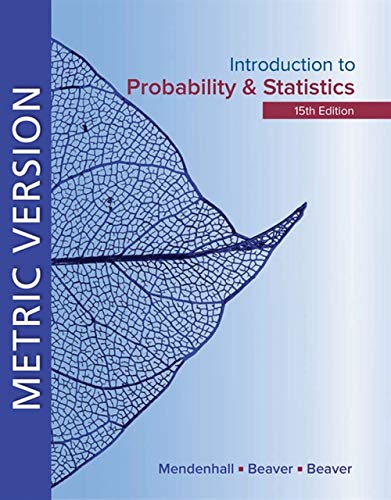(Dotplots, Stem and Leaf Plots, Histograms) The top 50 over-the-counter (OTC) stocks in a recent year were...
Question:
(Dotplots, Stem and Leaf Plots, Histograms) The top 50 over-the-counter (OTC) stocks in a recent year were found using an equal weighting of 1-year total return and average daily dollar volume growth. These 50 weightings, or averages, are listed in Table 1.19.16 Create a new worksheet (File ➤ New ➤ Worksheet). Enter the data into column C1 and name it “Average”
in the gray cell just below the C1.

1. To create a dotplot, use Graph ➤ Dotplot. In the Dialog box that appears, choose One Y ➤ Simple and click OK. To create a stem and leaf plot, use Graph ➤ Stem-and-Leaf.
For either graph, place your cursor in the “Graph variables” box, and select “Average”
from the list to the left (see Figure 1.26).

2. You can choose from a variety of formatting options before clicking OK. The dotplot appears as a graph, while the stem and leaf plot appears in the Session window. To print either a Graph window or the Session window, click on the window to make it active and use File ➤ Print Graph (or Print Session Window).
3. To create a histogram, use Graph ➤ Histogram. In the Dialog box that appears, choose Simple and click OK, selecting “Average” for the “Graph variables” box. Select Scale ➤ Y-Scale Type and click the radio button marked “Frequency.” (You can edit the histogram later to show relative frequencies.) Click OK twice. Once the histogram has been created, right-click on the y-axis and choose Edit Y-Scale. Under the tab marked “Scale,” you can click the radio button marked “Position of ticks” and type in 0 5 10 15 20. Then click the tab marked “Labels,” the radio button marked “Specified”
and type 0 5/50 10/50 15/50 20/50. Click OK. This will reduce the number of ticks on the y-axis and change them to relative frequencies. Finally, double-click on the word “Frequency” along the y-axis. Change the box marked “Text” to read “Relative Frequency” and click OK.
4. To adjust the type of boundaries for the histogram, right-click on the bars of the histogram and choose Edit Bars. Use the tab marked “Binning” to choose either “Cutpoints”
or “Midpoints” for the histogram; you can specify the cutpoint or midpoint positions if you want. In this same Edit box, you can change the colors, fill type, and font style of the histogram. If you right-click on the bars and select Update Graph Automatically, the histogram will automatically update when you change the data in the “Average” column.
As you become more familiar with MINITAB, you can explore the various options available for each type of graph. It is possible to plot more than one variable at a time, to change the axes, to choose the colors, and to modify graphs in many ways. However, even with the basic default commands, it is clear that the distribution of OTC stocks in Figure 1.27 is highly skewed to the right.

Step by Step Answer:

Introduction To Probability And Statistics
ISBN: 9780357114469
15th Edition
Authors: William Mendenhall Iii , Robert Beaver , Barbara Beaver





